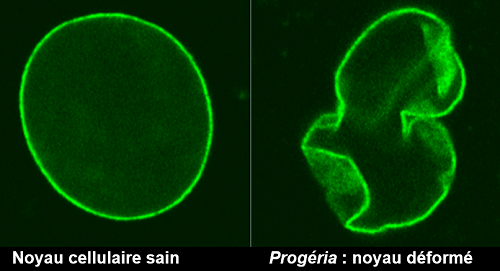Progeroid laminopathies are characterized by the premature appearance of certain signs of physiological aging in a subset of tissues. They are caused by mutations in genes coding for A-type lamins or lamin binding proteins.
Here, scientists from SB2SM/I2BC review how different mutations causing progeroid laminopathies alter protein structure or protein-protein interactions and how these impact on mechanisms that protect cell viability and function. Targeting these molecular alterations in A-type lamins and associated proteins identified through structural biology studies could facilitate the design of therapeutic strategies to treat patients with rare but severe progeroid laminopathies.

Uniform shape healthy nucleus (left); Nucleus with aberrant morphology in Progeria (right)
Image adapted from : The Cell Nucleus and Aging: Tantalizing Clues and Hopeful Promises. Scaffidi P, Gordon L, Misteli T. PLoS Biology 2005 3(11): e395. https://doi.org/10.1371/journal.pbio.0030395